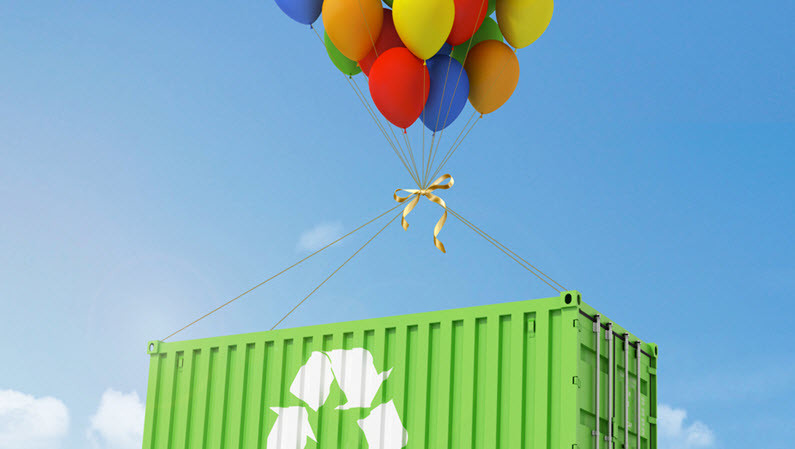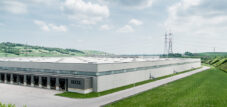Im Lager gleichzeitig Energie und Kosten sparen
Schlagzeilen zum Klimawandel, dem Anstieg der Meeresspiegel oder der globalen Erderwärmung finden sich alltäglich in den Medien. Kein Wunder, beschäftigt Nachhaltigkeit zum Schutz der Umwelt doch viele Menschen. Auch in der Intralogistik ist das Thema präsent, und so nimmt die Reduzierung von CO2-Emissionen und der Stärkung der Energieeffizienz einen immer höheren Stellenwert ein. Neben gesellschaftlichen hat dies auch finanzielle Gründe, führen ein geringer Energieverbrauch und eine verbesserte CO2-Bilanz doch direkt zu Kostensenkungen und einer Steigerung der Profitabilität.
Zur Gestaltung nachhaltiger Logistiksysteme und damit einer grünen Logistik können neben dem Transportbereich vor allem Intralogistiker beitragen. Dabei stehen bei der umweltgerechten Gestaltung des Lagers eine energieeffiziente Beleuchtung, Heizungs- und Lüftungstechnik sowie die Nutzung erneuerbarer Energien samt einer effektiven Wärmedämmung im Mittelpunkt der Bestrebungen. Des weiteren zielen die Ansätze auf eine effizientere Fördertechnik, leistungsfähige Softwaresysteme, moderne Lagergeräte und die Vermeidung von Leerläufen ab.
Energieeffizienz im Lager
Nachhaltiges Lagermanagement hat die Aufgabe, Bereiche wie Lagerung, Kommissionierung, Verpackung und Versand möglichst CO2– und energieschonend zu betreiben. Nach einer Studie des World Economic Forum von 2009 sind Lagergebäude für geschätzte 13 Prozent der CO2-Emissionen des Frachtsektors verantwortlich. Dazu wurde in einer Untersuchung des Logistikerstellers Vanderlande festgestellt, dass 24 Prozent der Energiekosten einer Supply Chain auf den Bereich der Intralogistik entfallen, was sie zu einem wesentlichen Kostenfaktor für Logistikdienstleister macht.
Für Logistiker trägt eine effiziente Energienutzung in den Lagerhallen also nicht nur zu Kostenreduzierungen, sondern auch zu einer Verbesserung der CO2-Bilanz bei. Nicht unwichtig angesichts der hoch gesteckten Ziele der Bundesregierung zur Verringerung des CO2-Ausstoßes. Innerhalb der Intralogistik hat mit 48 Prozent der Bereich Förder-, Lager- und Kommissioniertechnik den größten Energiekostenanteil. Er wird gefolgt von der Heizungs- und Lüftungstechnik mit 35 Prozent. Weitere 15 Prozent entfallen auf die Lichttechnik.
Effizienzsteigerung durch innovative Beleuchtungstechnik
Durch Einsatz einer modernen Beleuchtungstechnik kann der Verbrauch um bis zu 90 Prozent gesenkt werden. Für die angestrebten Energieeinsparungen ist in erster Linie die Wahl geeigneter Leuchtmittel verantwortlich. Hier sind LED-Lampen aufgrund ihres vergleichsweise niedrigen Verbrauchs, der längeren Haltbarkeit und des deutlich höheren Wirkungsgrads gegenüber konventionellen Glühlampen momentan die beste Wahl.
Doch die effektivsten Stromsparer nützen wenig, wenn sie pausenlos laufen und so den Verbrauch unnötig erhöhen. Vielerorts wurde im Lager deshalb dazu übergegangen, Bewegungsmelder einzusetzen, die eine selektive Beleuchtung nach Bedarf ermöglichen. So benötigen Lagerbereiche für B- und C-Artikel zumeist eine große Fläche und werden seltener aufgesucht. Anstatt den gesamten Bereich ständig komplett auszuleuchten, kann hier durch eine intelligente Lichtsteuerung viel Energie gespart werden. Eine effektive Anlage beleuchtet die Lagergassen lediglich dann, wenn sie von einem Kommissionierer aufgesucht werden. Auch werden die Leuchtquellen nicht mehr wahllos über das gesamte Lagerareal verteilt, sondern nur noch dort verwendet, wo sie auch benötigt werden: In den Gängen zwischen den Regalen, den Kommissionierstationen und Zufahrtswegen für An- und Abtransport der Waren. Allein durch derartige Maßnahmen lassen sich bis zu 40 Prozent des vorherigen Energiebedarfes für die Beleuchtung einsparen.
Energiesparende Lagersysteme
Ein großes Einsparpotential bieten moderne Lagersysteme, mit denen sich im Vergleich zu herkömmlichen Regallagerlösungen der Energieverbrauch um bis zu 40 Prozent reduzieren lässt. Dafür sorgen insbesondere:
Konstruktion der Geräte in Leichtbauweise:
Weniger Gewicht bei den zu bewegenden Teilen ist gleichbedeutend mit einem geringeren Verbrauch.
Kompakte Bauweise:
Die Geräte erlauben konstruktionsbedingt eine hochverdichtete Lagerung, was bei gleichem Lagervolumen zu deutlichen Einsparungen beim Platzbedarf führt. Folglich können kleinere Lagerimmobilien realisiert werden.
Energieeffiziente Antriebstechnologien mit leistungsstarken Motoren:
Aufgrund eines effizienten Zusammenspiels von Elektromotoren, Getrieben mit hohem Wirkungsgrad und optimal darauf abgestimmter Steuerungssoftware laufen die Lagersysteme ressourcenschonender und schneller.
Intelligente Unlastüberwachung:
Eine zu hohe Unlast führt zur Überlastung von Motoren und damit zu einem hohen Energieverbrauch. Je geringer die Unlast, desto weniger werden Motor und Mechanik beansprucht und umso weniger Energie wird benötigt. Eine moderne Unlastüberwachung hilft, das zu bewegende Gewicht gleichmäßiger zu verteilen. Dadurch werden Motor und Mechanik geschont und der Energiebedarf reduziert.
Einrichtung des Stand-by-Betriebs:
Bei – auch kurzer – Nichtbenutzung schalten die Geräte automatisch in den Stand-by-Modus. Dabei werden alle elektrischen Verbraucher in eine Art Schlafzustand versetzt, und auf diese Weise Energie gespart.
Wegeoptimierung:
Die Transportgeräte wählen immer den kürzesten Verfahrweg bei Ein- und Auslagerungen. Dadurch werden unnötige Wege, Zeit und letztlich Energie gespart.
Softwaregesteuerte Lager- und Kommissionierstrategien:
Eine moderne Lagerverwaltungssoftware fasst mehrere Aufträge zu einem Batch zusammen. Dadurch wird ein Lagergut, das für mehrere Aufträge benötigt wird, nur einmal angefahren. Darüber hinaus erlaubt das System schnellere und präzisere Picks und minimiert so zusätzliche, durch Fehler verursachte, Aktionen.
Automatische Beleuchtung:
Die Beleuchtung wird nur dann eingeschaltet, wenn ein Tablar mit der zu kommissionierenden Ware in der Bedienöffnung bereitsteht.
Energiesparende Heiz- und Kühlsysteme im Lager
Abhängig von ihrer geografischen Lage müssen Logistikeinrichtung in vielen Fällen beheizt oder gekühlt werden. Zum einen, damit das Lagergut nicht verdirbt oder beschädigt wird, zum anderen aber, damit die Beschäftigten vernünftige Arbeitsbedingungen vorfinden. Neben einer umfassenden Wärmeisolierung der Immobilie kann der Betreiber durch Einsatz einer modernen Heizungs- oder Kühlanlage den Verbrauch senken und damit Kosten sparen.
Etwas komplizierter wird es für Betreiber von Kühllagern, denn die angemessene Temperierung der Ware, die von –10°C für Tiefkühlfleisch bis zu 20°C für Konsumgüter reichen kann, trägt erheblich zum Energieverbrauch eines Lagers bei. Dort bietet die Installation eines modernen Kühl-, beziehungsweise Heizsystems eine gute Möglichkeit, die Energieeffizienz in der Lagerhaltung zu verbessern. Zusätzlich bedarf es auch hier natürlich einer guten Dämmung.
Ein weiterer Ansatz ist die verstärkte Automatisierung dieses Bereichs. Auf diese Weise kann der Verbrauch durch Beleuchtung und sich öffnende und schließende Tore verringert werden. Außerdem wird vermieden, dass Mitarbeiter in diesem klimatisch bedenklichen Bereich tätig sind. Andererseits entsteht durch die Automatisierung von Kühllägern zusätzlicher Energieverbrauch durch die installierten Antriebe.
Einige Betreiber von Lagerhallen setzen auf die räumliche Abtrennung der Klimazonen in Form von Luftwänden, sogenannten Toren aus Luft. Diese erlauben eine barrierefreie Trennung unterschiedlicher Klimazonen im Lager und können ihrerseits zu einer höheren Energieeffizienz im Lager beitragen.
Wegfall von Beleuchtung und Heizung bei Automatisierung
Eine weitere Entwicklung in der Intralogistik macht die geschilderten Anforderungen hinsichtlich optimaler Beleuchtung und Klimatisierung für die Beschäftigten im Lager bald vielleicht obsolet: die fortschreitende Automatisierung.
In immer mehr Einrichtungen werden die Waren softwaregesteuert abgerufen und bereitgestellt; werden die einzelnen Artikel von autonom durch die Gänge flitzenden Transportrobotern eingesammelt und zur vollautomatischen Kommissionierung gebracht, von wo aus sie über ein Förderband direkt an Montagelinien oder vor den Hallen wartende LKW geschickt werden. In dieser menschenleeren Intralogistik braucht es keine Lampen mehr, steuern die Roboter ihr Ziel doch per GPS oder Induktionsschiene an und picken die Gegenstände mit Hilfe von Infrarotsensoren oder integrierten RFID-Chips. Die Geräte brauchen auch keine Heizung oder Klimaanlage, da sie nicht schwitzen oder sich erkälten können. Und im meist relativ breiten Rahmen ihrer empfohlenen Betriebstemperatur lassen sich bei weitem großzügigere Temperaturen im Lager realisieren. Ob das ohne jegliche menschliche Arbeitskraft operierende Lager jedoch als nachhaltig-ökologisch wirtschaftend zu bezeichnen ist, ist eine ganz andere Frage.


